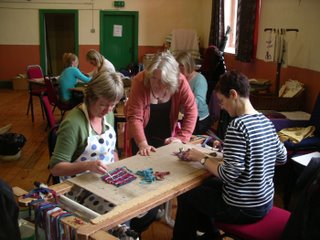Rob, Brock and I had a day out last week to the charming Cumbrian village of Caldbeck.
This is the village green or commons, where sheep were grazing.
The beck running through the village. Our walk was around the surrounding roads and lanes, although there are longer walks in the area if you are feeling energetic.
A small bridge over Cald Beck, with overgrown steps leading down to the water.
Interior of the Watermill Café. I love the old, beamed roof and stone walls. There are preserves and flour and other items for sale. Rob had the quiche of the day with salads and I had a jacket potato with cheesy beans and side salad, with two coffees, the bill came to £22.50. The salads were very good.
There is a tiny shop called Little Crooked Tree opposite to the entrance of the cafe, selling a range of crafts and gifts. I bought a lovely sheep/patchwork card by artist, E B Watts; and then we visited The Wool Clip next door, which has a host of handmade, wool-related products for sale, including supplies, such as the darning wool I bought made or dyed by Wild Woods Wool (although, not for darning with!). They also had some beautiful handwoven scarves by Jan Beadle and tufted rugs and wall hangings.
An enjoyable trip, and it was fairly quiet now that the summer holidays are over, so it was a good time to visit.
This is the village green or commons, where sheep were grazing.
The beck running through the village. Our walk was around the surrounding roads and lanes, although there are longer walks in the area if you are feeling energetic.
A small bridge over Cald Beck, with overgrown steps leading down to the water.
There is a church, a pub, several shops and two cafés in the village. We went to the Watermill Café at Priest's Mill. There is a small car park nearby, or a larger one in the village. Unusually for Cumbria, both are free of charge!
Interior of the Watermill Café. I love the old, beamed roof and stone walls. There are preserves and flour and other items for sale. Rob had the quiche of the day with salads and I had a jacket potato with cheesy beans and side salad, with two coffees, the bill came to £22.50. The salads were very good.
There is a tiny shop called Little Crooked Tree opposite to the entrance of the cafe, selling a range of crafts and gifts. I bought a lovely sheep/patchwork card by artist, E B Watts; and then we visited The Wool Clip next door, which has a host of handmade, wool-related products for sale, including supplies, such as the darning wool I bought made or dyed by Wild Woods Wool (although, not for darning with!). They also had some beautiful handwoven scarves by Jan Beadle and tufted rugs and wall hangings.
An enjoyable trip, and it was fairly quiet now that the summer holidays are over, so it was a good time to visit.



















